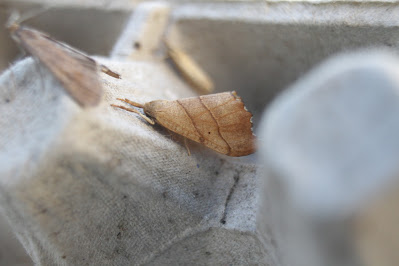The moth year list has been climbing steadily over the last few weeks, now on 378 (awaiting verification) for our garden here in Worminghall. Here's a few highlights and queries from July. Any corrections to identifications much appreciated.
Nice to get a smart looking Vestal. Also had up to 7 Rush Veneer on one night, a few Diamond-back Moths but only a single Rusty Dot Pearl. A Hummingbird Hawkmoth was also feeding on the lavenders last weekend.
Scalloped Hook-tip was a welcomed overdue first for the garden
Small Rivulet (above) and Small Dotted Buff (below) also overdue firsts
Two Dioryctria (above and below). The above I thought perhaps sylvestrella and the one below perhaps simplicella?
Is this another Moitrelia obductella?
A Hellinsia sp?
Large Twin Spot Carpet I presumed
Two moths here from an away night trapping at Waterstock Mill just over the border in Oxon. I'm pretty sure the top one is Orthotelia sparganella and perhaps the one below is Schoenobius gigantella?











It's a bit beaten up, but I think your first 'Dioryctria' may be Assara terebrella.
ReplyDeleteSome great moths there, Peter! I agree with sparganella and obductella (as others have said, latter is spreading rapidly and breeding on the Chilterns, I found larvae at Aston Rowant this year). I think based on how feathery the trailing edges of the wing are, and the slight curve in them, that your plume is a Merrifieldia species rather than a Hellinsia (I feel like the latter tend to look quite stubby and compact). These species can wear a lot, to look much whiter than they appear in most photos/books, where they look kind of brownish. There are two in our area, Thyme Plume and Dingy White, which are found most commonly up on the Chilterns, but I've seen Dingy White (at least) away from there. My gut is that yours is Dingy White (I think I can see a hint of a dark line on the forewing costa and it looks quite large), which is slightly more frequent, but with such a worn one I'm not sure I'd commit to that.
ReplyDeleteHi Peter,
ReplyDeleteThe Carpet is indeed Large Twin-spot. Of the moths not already mentioned by Will, the putative Dioryctrias aren't really do-able from those pictures (needs a much closer image and clear indication of size but even then they are extremely difficult, even with the actual moth in front of you). The last one could be either gigantella as you suggest or else Donacaula forficella (the males in particular can be far more difficult to tell apart than the illustrations in the field guide suggest) and I'd have wanted that one dissected. Both are quite likely to be found at Waterstock.
Thanks all for the feed back. Very helpful and interesting indeed.
ReplyDelete